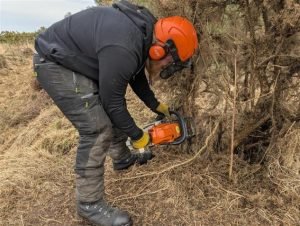Sand lizard and adder among New Forest reptiles benefitting from restoration work
PUBLISHED ON: 2 APRIL 2025Three of the most threatened reptile species are set to receive a huge boost to their recovery rate in the New Forest.
Sand lizard, smooth snake and adder are particularly vulnerable to threats such as climate change, recreational pressures and fires, which can severely damage their habitats.
The Amphibian and Reptile Conservation Trust (ARC) is creating and restoring heathlands in the Forest to enable the recovery of these species and improve the resilience of their habitats.
To date, much of the focus has been on creating a more open heathland by clearing overgrown gorse, creating ideal spaces for reptiles to forage, breed, and bask.
The restoration work is part of the £1.3million Species Survival Fund project, which is funded by the UK Government and delivered by the National Lottery Heritage Fund.
The New Forest National Park Authority (NPA) is leading the project in conjunction with ARC, Freshwater Habitats Trust (FHT), Hampshire and Isle of Wight Wildlife Trust (HIWWT), New Forest Commoners Defence Association (CDA) and Wild New Forest, to reverse the loss of habitats and species by enhancing 250 hectares of land for nature – the equivalent of 350 football pitches.

Sand lizard and smooth snake are both European-protected species, while adders are classed as nationally vulnerable.
‘All three are facing several threats both nationally and locally, impacting the range and distribution of populations, and the habitats that support them,’ said ARC project officer Eryn McDonald.
‘This type of work helps to restore lowland heathlands to a favourable condition, supporting the species that rely on these surroundings.
‘It also helps link up the habitats from inside the Forest to the surrounding areas, creating a bigger, better, more joined up landscape.’
The New Forest National Park is home to all six of the UK’s native reptile species: adder, sand lizard, slow-worm, grass snake, common lizard and smooth snake. All six will benefit from the restoration work.
The project is funded by the Government’s Species Survival Fund. The fund was developed by Defra and its Arm’s-Length Bodies. It is being delivered by The National Lottery Heritage Fund in partnership with Natural England and the Environment Agency.
Working in partnership enables experts to combine their knowledge, expertise and resources with each other to ensure the best possible impact is made on the landscape.
Pictured top: Adder (credit Chris Dresh)

